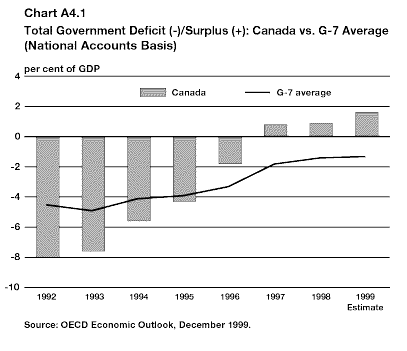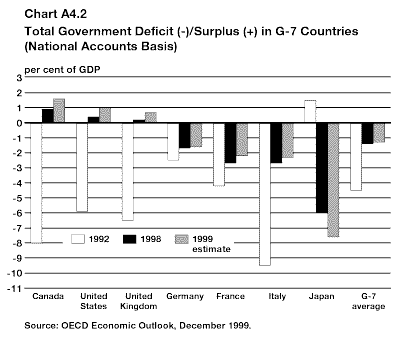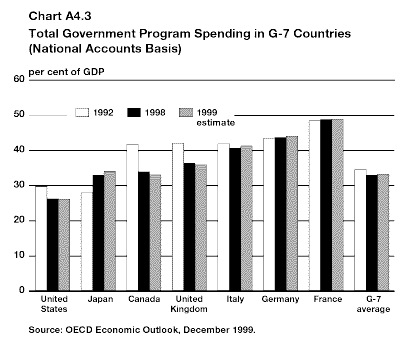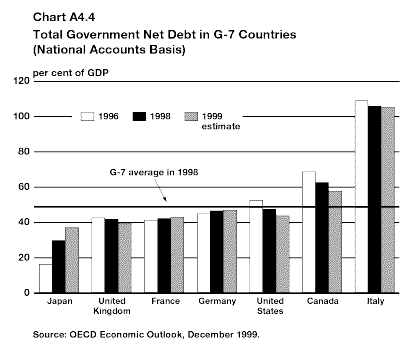
Budget Plan - Annexes

|
|
|
Annexes 4-6 |
| - Franšais - Table of Contents - | |
- Annex 4 - Annex 5 - Annex 6 -
This annex compares Canada’s improving financial position with that of the other Group of Seven (G-7) countries (United States, United Kingdom, France, Germany, Japan and Italy).
Two factors tend to complicate international financial comparisons. First, differences in accounting methods among countries affect the comparability of the data. Second, financial responsibilities are distributed differently among the various levels of government in each country. For these reasons, the standardized System of National Accounts definitions and data, which are fairly uniform across countries, are used for the government sector when making fiscal comparisons. The Organisation for Economic Co-operation and Development (OECD) produces a complete series of estimates based on this system. The data presented here are based on the OECD’s December 1999 forecasts and, as such, do not include any data revisions since then.
Following the recession of the early 1990s, the total Canadian government sector1 deficit peaked at 8 per cent of gross domestic product (GDP) in 1992, compared to the G-7 average deficit-to-GDP ratio of 4.5 per cent that same year.
Subsequent deficit reduction efforts by all levels of Canadian government resulted in a total government budget surplus in 1997. This has since been maintained. The OECD estimates that Canada’s budget surplus will reach 1.6 per cent of GDP in 1999, compared to an average deficit of 1.3 per cent of GDP in the G-7 countries (Chart A4.1).

Canada’s budgetary improvement over the 1992-1999 period surpassed that of all other G-7 countries. Over this period, Canada recorded a turnaround of nearly 10 percentage points (Chart A4.2). The only other G-7 countries expected to post a surplus in 1999 are the United States and the United Kingdom.

Sharp cuts in program spending have enabled Canada to quickly put its fiscal house in order. In 1992, Canada’s program spending as a share of GDP was well above the G-7 average (Chart A4.3). Between 1992 and 1999, Canada implemented the largest reduction in program spending relative to GDP of any G-7 country: program spending as a percentage of GDP dropped about 8.5 percentage points, compared to an average of about 1.5 points for the G-7 countries. In relation to the size of the economy, Canada’s program spending is now on a par with the G-7 average.

Over the past few years, Canada has experienced the sharpest decline in the debt-to-GDP ratio of the G-7 countries. However, despite this recent progress, Canada’s debt burden remains high in an international context. In 1999, Canada’s debt-to-GDP ratio was about 10 percentage points above the G-7 average (Chart A4.4). A further reduction in the debt burden remains a key objective of Canadian governments’ fiscal policy.

Estimates of the main fiscal aggregates are sensitive to changes in economic assumptions – particularly to the level of nominal gross domestic product (GDP) and interest rates. The following sensitivity estimates capture the direct fiscal impacts of changes in these variables. These are static calculations that capture the impact of the changes one economic variable at a time. For example, in the nominal income sensitivity estimate, there is no feed-through of the change in nominal income to other variables, such as interest rates.
In addition, the sensitivity estimates assume that changes in economic assumptions do not affect the Government’s balanced budget targets. Positive economic developments are assumed to translate into greater policy action in future budgets. Negative economic developments are assumed to be accommodated by the prudence set aside in the budget. As a result, the estimates do not allow, for example, for second order effects of changes in nominal income on the level of debt and, therefore, debt charges.
A 1-per-cent increase in the level of nominal GDP leads to higher tax bases and thus higher revenues. The ultimate budgetary impact would depend on the source of the increase in nominal income. The most favourable impact on the fiscal situation would occur if all of the increase in nominal GDP resulted from increased real output. Revenues would be higher while interest rates would be relatively stable.
If, however, the improvement in nominal GDP were solely due to inflation, then higher spending on those programs indexed to inflation would offset some of the positive impact on government revenues. Moreover, with the indexation of the personal income tax system announced in this budget, the revenue gain from an increase in inflation is now less than the gain from an increase in real output.
Assuming the 1-per-cent increase in nominal income comes solely from an increase in real output, the budgetary balance would improve by $2.1 billion in the first year, rising to $2.4 billion after four years (Table A5.1). Revenues would increase $1.6 billion in the first year, rising to $1.8 billion by the fourth year. Expenditures would decline $0.5 billion, almost entirely due to the reduction in employment insurance (EI) benefits that would follow from the reduction in the level of unemployment normally associated with an increase in output.
Table A5.1
Fiscal Sensitivity Analysis: 1-Per-Cent Increase in Nominal Income
| Estimated changes in fiscal position | ||||
|---|---|---|---|---|
| Year 1 | Year 2 | Year 3 | Year 4 | |
| (billions of dollars) | ||||
| Budgetary transactions | ||||
| Revenue increase | 1.6 | 1.7 | 1.8 | 1.8 |
| Expenditure reduction | 0.5 | 0.5 | 0.5 | 0.5 |
| Improvement in budgetary balance | 2.1 | 2.2 | 2.3 | 2.4 |
| Note: Numbers may not add due to rounding. | ||||
These estimates are higher than those presented in the 1999 budget. This is because the sensitivity estimate described above captures the effect of changes in output on the EI program, while the estimates included in the 1999 budget did not. As noted in the 1999 budget, the EI program increases the sensitivity of the budget balance to changes in real output by close to $650 million in the first year of the shock. This consists of just under $150 million in higher EI revenues and just under $500 million in lower EI benefits.
Changes in market interest rates, all other things remaining equal, result in changes in public debt charges and revenues from interest-bearing assets. The ultimate budgetary impact will depend on the magnitude of the change in market rates, the size and composition of the debt stock and the amount of interest-bearing assets.
A sustained 100-basis-point decline in all interest rates would cause the budget to improve by $900 million in the first year, rising to $2.2 billion in the fourth year (Table A5.2). Expenditures (public debt charges) would fall $1.2 billion in the first year. As longer-term debt matures and is refinanced at the lower interest rates, the positive impact on public debt charges would increase, reaching $2.7 billion by year four. However, the positive impact on public debt charges due to the decline in market interest rates would be somewhat offset by a reduction in interest earnings on the Government’s interest-bearing assets (which are accounted for in non-tax revenue). These assets largely consist of assets in the Exchange Fund Account, Bank of Canada assets and the Government’s cash balances, which are invested in short-term securities.
Table A5.2
Fiscal Sensitivity Analysis: 100-Basis-Point Decrease in Interest Rates
| Estimated changes in fiscal position | ||||
|---|---|---|---|---|
| Year 1 | Year 2 | Year 3 | Year 4 | |
(billions of dollars) |
||||
| Budgetary transactions | ||||
| Revenue reduction | 0.3 | 0.4 | 0.4 | 0.5 |
| Expenditure reduction | 1.2 | 1.9 | 2.4 | 2.7 |
| Improvement in budget balance | 0.9 | 1.5 | 2.0 | 2.2 |
| Note: Numbers may not add due to rounding. | ||||
In the 1999 Public Accounts of Canada, the Auditor General expressed a clean opinion on the Government’s financial statements for 1998-99. This marks the sixth time in the last eight years he has endorsed the Government’s financial statements.
However, as in previous years, the Auditor General raised a number of issues which, in his opinion, are "matters requiring continuing attention." These are:
The Government’s responses to the Auditor General’s observations on the 1999 financial statements are discussed in detail in this annex.
In the 1999 budget, the federal government announced a Canada Health and Social Transfer (CHST) cash supplement of $3.5 billion and booked the liability in 1998-99. The Auditor General explains in his report why he accepted the booking of this liability but not the bookings of the liabilities related to the Canada Foundation for Innovation (CFI) in 1996-97 and the Canada Millennium Scholarship Foundation in 1997-98.
The Government recognizes that the booking of the liabilities for the CFI and the Canada Millennium Scholarship Foundation is an area where existing accounting standards do not offer explicit guidance and that professional judgment must be brought to bear. The Government has consistently argued that its decisions to provide funding to arm’s-length organizations, such as the CFI and the Canada Millennium Scholarship Foundation, established liabilities that should be recorded in the year that the decisions to provide funding were made. The Government consulted two major accounting firms, both of which endorsed the Government’s approach.
This treatment enhances transparency and accountability to Parliament and Canadians. The Government has been consistent in this practice and will continue to apply it in the future. As such, in accordance with its stated accounting policy, non-recurring liabilities will be recognized in the year the decision to incur them is made, provided the enabling legislation or authorization for payment receives parliamentary approval before the financial statements for that year are finalized.
Further, the Auditor General reports that during the course of the past year he undertook research on the accounting treatment of such "special purpose entities" to determine if they should be consolidated in the Government’s financial statements as part of the Government’s overall reporting entity. From his research, he concludes that the application of current PSAB (Canadian Institute of Chartered Accountants’ Public Sector Accounting Board) accounting recommendations requires considerable judgment to determine the appropriate accounting treatment. He "strongly recommends that the Government encourage PSAB to provide additional guidance in the form of either an Accounting Guideline or a change in the PSAB Handbook."1
Both the CFI and the Canada Millennium Scholarship Foundation were established as arm’s-length organizations for sound public policy reasons. As arm’s-length organizations, these foundations operate outside the influence of political considerations and can attract funding from the private sector to pursue their objectives. The Government is committed to ensuring that these foundations operate without government interference. The Government continues to believe that, in its application of PSAB recommendations, these entities should not be considered part of government and therefore should not be consolidated within its financial statements.
Currently, the Government records most of its expenditures and non-tax revenues on an accrual basis of accounting. In contrast, tax revenues and capital assets are recorded on a cash basis of accounting. In previous budgets, the Government has indicated its intention to move to full accrual accounting and the Auditor General has supported this move. Although he has once again expressed concern that the Government may not be in a position to implement this in a timely fashion, he acknowledges that "the Government has made progress toward its objective."2
The specific areas where the Auditor General comments on progress being made include Aboriginal claims, environmental liabilities, accrual of tax revenues, enterprise Crown corporations, capital assets, prepaid expenses and inventories. Although fully supportive of the Government’s goal and strategy to implement all of these accounting policy changes in 2001-02, he believes that it is ambitious and that considerable work remains to be done.
The Government recognizes the implementation of the Financial Information Strategy (FIS) and "full" accrual accounting as a priority and recently provided additional support to departments in this area. It will continue to work closely with the Office of the Auditor General to ensure the successful implementation of the FIS and full accrual accounting in 2001-02.
The Auditor General points out that the Government currently reports revenues and expenditures on a net basis. For budgetary purposes, there are a number of tax expenditures that are netted against revenues and a number of revenue items that are netted against spending. Netted against revenues are the Canada Child Tax Benefit (CCTB), the quarterly goods and services tax (GST) credit and repayments of Old Age Security benefits. Netted against spending are revenues of consolidated Crown corporations and revenues from levies charged by departments for specific services, such as the costs of policing services in provinces. This netting has no impact on the overall budgetary balance.
The Auditor General has recommended that the financial statements and the budget be prepared only on a gross basis. Of particular concern to the Auditor General is the CCTB, which is currently netted against personal income tax revenues. The Auditor General argues that this represents "incomplete financial disclosure."3
In fact, the Government already publishes this information each year in the fall. Both the Annual Financial Report of the Government of Canada and the Public Accounts, which contain the audited financial results of the Government, report revenues and expenditures on both a "gross" and "net" basis.
The "net" presentation is the appropriate approach for the budget because it is consistent with the way that Parliament appropriates funds. Furthermore, programs like the CCTB and the quarterly GST credit are integral parts of the tax system. These programs are administered through the tax system. They are thus netted from tax revenues for budgetary purposes.
The Auditor General has questioned the amount of time it takes for the Government to prepare the year-end financial statements. Moreover, he argued that a number of departments do not consider themselves accountable for the Public Accounts in the preparation of these statements.
The 1999 Public Accounts were finalized within six months of the end of the 1998-99 fiscal year, almost a month earlier than the previous year. Timely financial reporting is a priority and the Government will ensure that adherence to reporting deadlines is monitored, enforced and improved where feasible.
The Debt Servicing and Reduction Account (DSRA) was established by statute in June 1992. Under that legislation, all GST revenues, net of applicable input tax credits, rebates and the low-income credit, along with the net proceeds from the sale of Crown corporations and gifts to the Crown explicitly identified for debt reduction, must be deposited into this Account. The funds in this Account are earmarked to pay interest on the public debt and, ultimately, to reduce the debt. In 1998-99, net revenues, primarily from the GST, amounted to $20.8 billion. In contrast, public debt expenditures chargeable to the Account were $30.8 billion.
In his 1996-97 observations, the Auditor General recommended that the Government re-examine the need for and usefulness of the DSRA. He raised this issue in his opening statement to the House of Commons Standing Committee on Finance in July 1998 and again in his observations on the 1998-99 financial statements.
In his 1996-97 observations, the Auditor General noted that "given the fundamental concept of the Consolidated Revenue Fund (CRF) underlying the Government’s accounting system, the Account is an internal mechanism that may not be necessary." All revenues received by the Government must be deposited in the CRF and any disbursements from it must be authorized by Parliament. Therefore, the specific revenues of the DSRA must be deposited in the CRF and the public debt expenditures chargeable to the Account must be appropriated from it by Parliament. Since all of the information relating to the DSRA is already reported in other parts of the Government’s financial statements, there appears to be limited usefulness in having a separate financial statement.
The House of Commons Standing Committee on Finance’s recommendations for the 2000 budget included elimination of the DSRA.
Although all of the information relating to the DSRA is already reported in other parts of the Government’s financial statements, as noted by the Auditor General, the Government believes that, at this time, the DSRA provides important information to Canadians on the flow of GST revenues, gifts to the Crown and the net gains associated with the disposals of investments in Crown corporations. This information is enhanced through the presentation of a separate audited statement. As a result, the Government does not propose any changes be made at this time.
The Auditor General approved of the changes made to the 1998-99 Annual Financial Report of the Government of Canada (AFR). In particular, he endorsed the inclusion of a user survey in the 1998-99 AFR and encouraged the Government to use the results of the user survey to continually improve the document.
The AFR is available both in printed format and on the Department of Finance Canada Internet site. A total of 2,460 printed copies of the AFR for 1998-99 have been circulated with a roughly comparable number of "hits" on the Internet site. In total, there were 51 responses to the questionnaire. Although the survey was not scientific, some of the relevant results are summarized below.
Results regarding the content and organization of the AFR were generally very positive. About one-half of those who completed the survey said that they were "somewhat satisfied," while about 30 per cent said that they were "very satisfied" with both organization and content.
The results also show that the majority of respondents felt that the AFR contained a sufficient amount of information.
How satisfied are you with the current content of the Annual Financial Report?
| Response | Number of responses |
% of respondents |
|---|---|---|
| Very satisfied | 17 | 33.3 |
| Somewhat satisfied | 24 | 47.1 |
| Somewhat dissatisfied | 3 | 5.9 |
| Very dissatisfied | 0 | 0.0 |
| Don’t know | 7 | 13.7 |
| Total | 51 | 100.0 |
How satisfied are you with the organization of the information in the Annual Financial Report?
| Response | Number of responses |
% of respondents |
|---|---|---|
| Very satisfied | 15 | 29.4 |
| Somewhat satisfied | 27 | 52.9 |
| Somewhat dissatisfied | 3 | 5.9 |
| Very dissatisfied | 1 | 2.0 |
| Don’t know | 5 | 9.8 |
| Total | 51 | 100.0 |
Is the information in the Annual Financial Report presented in:
| Response | Number of responses |
% of respondents |
|---|---|---|
| Enough detail | 36 | 73.5 |
| Not enough detail | 10 | 20.4 |
| Too much detail | 3 | 6.1 |
| Total | 49 | 100.0 |
1 Includes federal, provincial and local
governments as well as the balances in the Canada Pension Plan and Quebec Pension Plan.
2 Public Accounts of Canada 1999. Volume I:
Summary Report and Financial Statements, p. 1.35.
3 Public Accounts of Canada 1999. Volume I:
Summary Report and Financial Statements, p. 1.37.
| Budget 2000 Publications | Budget 2000 Main Page |